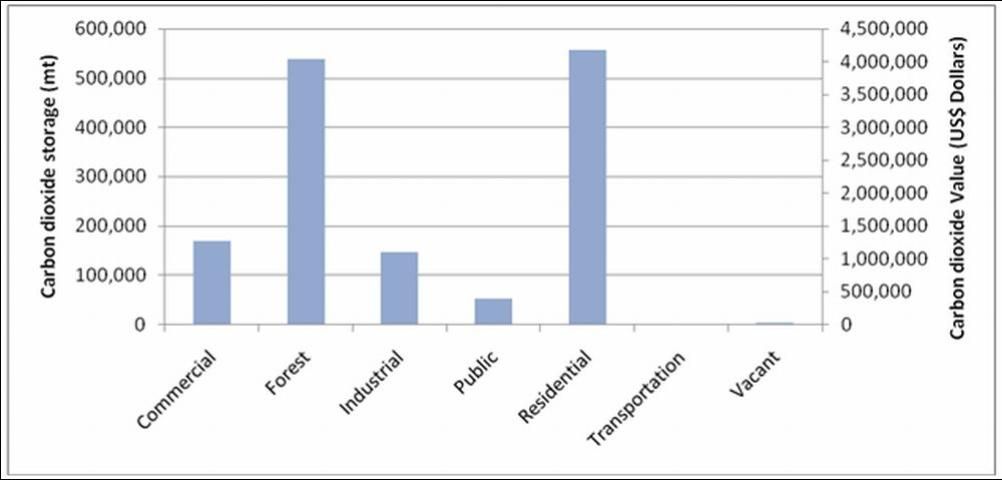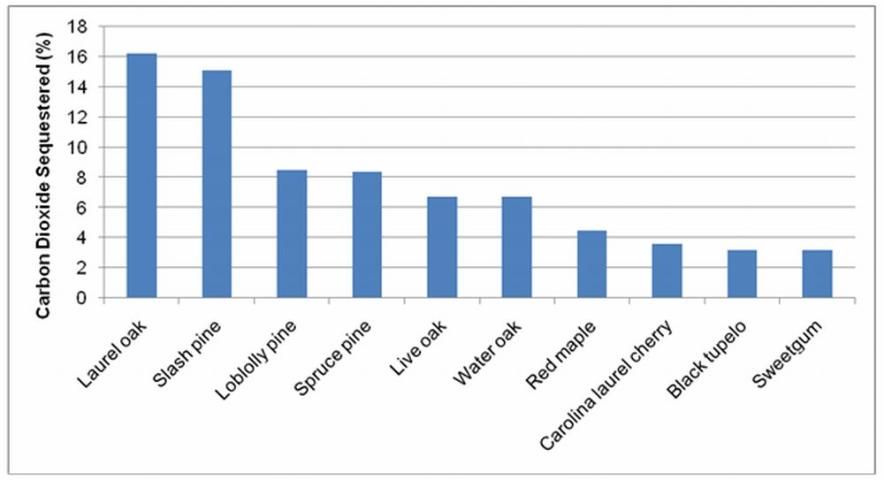Climate change is a world-wide issue, and it may seem as if only actions by national governments can work effectively against it. In fact, individuals and small communities, too, can make wise choices and impacts. Communities can mitigate climate change through reducing fossil fuel consumption and good management of its urban forest. Urban trees can reduce concentrations of atmospheric carbon dioxide by storing carbon in their roots, stems, and branches. Urban forests can also help reduce carbon dioxide emissions from fossil-fuel-based power plants because their shade and wind protection reduces energy consumption for heating and cooling buildings. By estimating the amount of carbon removed by trees using several available methods, we can determine the role of urban forests in mitigating climate change, offsetting local carbon dioxide emissions, and also assign an economic value to the amount of carbon sequestered by an urban forest.
Using the i-Tree ECO (formerly known as UFORE) urban forest ecosystem service model (https://www.itreetools.org/), researchers at UF/IFAS School of Forest Resources and Conservation (SFRC) and the USDA Forest Service estimated carbon storage and sequestration by urban trees in Gainesville, Florida (Escobedo et al. 2010). The SFRC researchers also used permanent monitoring plots, re-measurements over 3 years, and locally developed urban tree and regional allometric biomass equations to evaluate these i-Tree ECO model's estimates (Timilsina et al. 2014). Carbon storage is the estimated total amount of woody biomass held in a tree's stem and branches over its life. Carbon sequestration is the estimated amount of carbon a tree's stem and branches take up during one year of growth. Carbon in the below-ground roots of a tree was not accounted for. In 2006, the researchers collected data from 93, one-tenth-acre field plots located randomly across the city of Gainesville for the i-Tree ECO analysis. Both the model and the UF/IFAS SFRC evaluation study use tree species equations to estimate tree dry weight from stem diameter. Approximately 50% of a tree's dry weight biomass is carbon; the researchers estimated the dry weight and then divided by two in order to arrive at an estimate of the amount of carbon stored in Gainesville's trees. In estimating carbon sequestration, researchers accounted for average annual growth for different types of trees in different size classes and in different conditions (Nowak et al. 2002). The SFRC study, however, measured actual growth, mortality, and tree specific woody biomass (Timilsina et al. 2014). Since carbon value is traded in carbon offset markets in units of carbon dioxide, carbon estimates were then converted to carbon dioxide (CO2) equivalents. Values were multiplied by $4 per metric ton (mt) CO2 equivalent, or the August 2008 market value (http://www.ecosystemmarketplace.com/).
Table 1 compares the average amount of carbon stored and sequestered per tree by different size classes as estimated using i-Tree ECO. Large trees greater than 77 centimeters (about 33 inches) in diameter at breast height (dbh) sequester the most carbon in Gainesville. Overall healthier and larger trees sequester more carbon annually than do younger trees with a small dbh due to the limited growth and size. Eventually if small trees remain healthy and continue to grow, they will accumulate more carbon as their biomass increases. Trees in poor condition sequester less carbon than do healthy trees, and dead trees actually emit carbon as they decompose. Nevertheless, despite the loss of CO2 caused by dead trees, one should also consider the various ecosystem services that dead trees provide in forests, e.g., soil formation, nutrient recycling, and wildlife food and habitat (Janisch et al 2002; Ganfeldt et al 2013). For this reason, maintaining some dead trees in urban areas may be beneficial so long as they do not pose risk to life or property.
Since carbon is valued in terms of CO2 equivalents, C results were converted to CO2 by multiplying by 3.67. Figure 1 depicts a comparison of the economic value and CO2 stored by trees located in different land-use areas in Gainesville using the i-Tree ECO model. Trees in residential and forested areas store 76% of all CO2 and is more than trees in commercial or industrial areas simply because more of Gainesville is devoted to residential use and to forests than is devoted to commercial and industrial uses. However, by analyzing on a per-hectare basis, 1 hectare of forested land use can sequester 8 mt of CO2 per year while, residential and industrial areas in 1 year sequester 4 and 1 mt CO2 per hectare, respectively.
Comparison of average carbon stored and sequestered per tree by diameter at breast height (DBH) size classes in Gainesville, Florida according to i-Tree ECO results.

Credit: Escobedo et al. 2010.
As trees grow, they store more CO2 by assimilating it in their woody tissue. Conversely, as they die and decompose, they release much of the stored CO2 back into the atmosphere. Thus, CO2 sequestration can be negative if there are more dead than live trees (if more CO2 is being emitted by decomposing trees than is being sequestered by healthy, growing trees). Dead and decomposing trees in Gainesville emitted approximately 3,500 mt CO2 in the study year according to i-Tree ECO. Accounting for this loss, CO2 sequestration by trees is about 9,740 mt CO2 per year with a value of $38,954. Overall, and according to i-Tree ECO, trees in Gainesville capture, or offset, about 3% of all the annual human-related CO2 emissions in the city (Escobedo et al. 2010). However, using this same field data but accounting for actual measured tree growth, mortality, and biomass, SFRC researchers estimate that urban trees offset 5% of all anthropogenic CO2 emissions in 2008; 60% more than estimated by the available ECO model (Timislina et al. 2014). The SFRC researchers also found that i-Tree ECO under predicted individual tree C storage by 15% and could have errors of up to 37%.
The 10 tree species in the city that sequester the most CO2 are illustrated in Figure 2. Of all the species sampled, laurel oak (Quercus laurifolia) sequesters the most carbon dioxide, about 16% of the total CO2 sequestered. This is because laurel oaks are more abundant in Gainesville than other trees, including live oaks and tupelos. Live oaks are much less abundant than laurel oaks but because of their large size and greater life span they can sequester a greater portion of CO2 than other trees. Most of the trees in Figure 2 also are on the list of the ten most common trees found in Gainesville. For more information about common trees in Gainesville, read Gainesville's Urban Forest Structure, Composition, Size, and Density https://edis.ifas.ufl.edu/FR276.

Credit: Escobedo et al. 2010.
Conclusion
Cities are a major source of carbon dioxide emissions. As demonstrated by this fact sheet, urban and natural trees can help mitigate the effects of climate change somewhat by sequestering CO2 and can provide multiple other environmental, social, and economic benefits (Dobbs et al. 2010). Available methods and urban forest models such as i-Tree and the CUFR Tree Carbon Calculator (CCTCC) (https://www.fs.usda.gov/ccrc/tool/cufr-tree-carbon-calculator-ctcc) can be used to estimate urban tree CO2 storage and sequestration. However, users should be aware of model limitations and assumptions when interpreting these tools (Timilsina et al. 2014). The ability of trees to sequester CO2 can promote urban and rural forest management, particularly if market-based policies and programs for CO2 storage emerge. However, urban trees can only sequester a small portion of all carbon dioxide emitted from cities. In addition, decomposing trees and mulch, tree maintenance activities that use fossil-fuel-burning tools (e.g., chainsaws, leaf blowers, mowers, and cars and trucks), and improperly placed trees that cause shading in winter can also result in emissions of CO2 (Dobbs et al. 2011). It is important for communities to reduce fossil fuel emissions and manage for and preserve large, healthy trees to maximize the amount of CO2 sequestered by an urban forest.
Literature Cited
Dobbs, C., F. Escobedo, W. Zipperer. 2011. A framework for developing urban forest ecosystem services and goods indicators. Landscape and Urban Planning, 99:196-206.
Escobedo, F, S. Varela, M. Zhao, J. Wagner, W. Zipperer. 2010. Analyzing the efficacy of subtropical urban forests in offsetting carbon emissions from cities. Environmental Science and Policy, 13:362-372.
Gamfeldt L, Hillebrand H, Jonsson PR (2008) Multiple functions increase the importance of biodiversity for overall ecosystem functioning. Ecology 89:1223 -1231. doi: 10.1890/06-2091.1.
Janisch J. E., Harmon M. E. Successional changes in live and dead wood carbon stores: implications for net ecosystem productivity. Tree Physiol. 22, 77 -89 (2002).
Nowak, D.J. and D.E. Crane. 2002. Carbon storage and sequestration by urban trees in the USA. Environmental Pollution 116: 381-389.
Timilsina, N., Staudhammer, C., Escobedo, F.J., Lawrence, A. 2014. Tree biomass, wood waste yield, and carbon storage changes in an urban forest. Landscape and Urban Planning, 127:18-27.